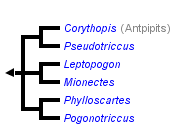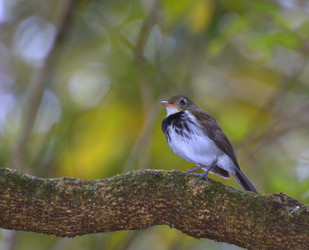Pipromorphini
John Harshman


This tree diagram shows the relationships between several groups of organisms.
The root of the current tree connects the organisms featured in this tree to their containing group and the rest of the Tree of Life. The basal branching point in the tree represents the ancestor of the other groups in the tree. This ancestor diversified over time into several descendent subgroups, which are represented as internal nodes and terminal taxa to the right.

You can click on the root to travel down the Tree of Life all the way to the root of all Life, and you can click on the names of descendent subgroups to travel up the Tree of Life all the way to individual species.
For more information on ToL tree formatting, please see Interpreting the Tree or Classification. To learn more about phylogenetic trees, please visit our Phylogenetic Biology pages.
close boxDiscussion of Phylogenetic Relationships
The genus Pipromorpha, for which this group is named, is commonly submerged within Mionectes, as it is here, though both genera may be monophyletic (Rheindt et al. 2008).References
Ohlson, J., J. Fjeldså, and P. G. P. Ericson. 2008. Tyrant flycatchers coming out in the open: Phylogeny and ecological radiation of Tyrannidae (Aves, Passeriformes). Zoologica Scripta 37:315-335.
Rheindt, F. E., J. A. Norman, and L. Christidis. 2008. Phylogenetic relationships of tyrant-flycatchers (Aves: Tyrannidae), with an emphasis on the elaenine assemblage. Mol. Phylogenet. Evol. 46:88-101.
Tello, J. G., and J. M. Bates. 2007. Molecular phylogenetics of the flatbill and tody-tyrant assemblage of tyrant flycatchers (Tyrannidae). Auk 124:134-154.
Tello, J. G., R. G. Moyle, D. J. Marchese, and J. Cracraft. 2009. Phylogeny and phylogenetic classification of the tyrant flycatchers, cotinga, manakins, and their allies (Aves: Tyrannides). Cladistics 25:1-39.
Title Illustrations

| Scientific Name | Corythopis delalandi |
|---|---|
| Location | Reserva Ambiental - Piraju-SP - Brasil |
| Comments | Além de emitir um bonito canto, o "estalador" produz um som de batida do bico parecido com um estalo (razão do nome comum), usado como alerta de algum perigo. Vive no interior das matas ciliares, cerradões e matas secas. Fonte: WikiAves |
| Specimen Condition | Live Specimen |
| Source | ESTALADOR (Corythopis delalandi) |
| Source Collection | Flickr |
| Image Use |
 This media file is licensed under the Creative Commons Attribution-ShareAlike License - Version 2.0. This media file is licensed under the Creative Commons Attribution-ShareAlike License - Version 2.0.
|
| Copyright | © 2009 Dario Sanches |
About This Page
Correspondence regarding this page should be directed to John Harshman at
Page copyright © 2009
 Page: Tree of Life
Pipromorphini.
Authored by
John Harshman.
The TEXT of this page is licensed under the
Creative Commons Attribution-NonCommercial License - Version 3.0. Note that images and other media
featured on this page are each governed by their own license, and they may or may not be available
for reuse. Click on an image or a media link to access the media data window, which provides the
relevant licensing information. For the general terms and conditions of ToL material reuse and
redistribution, please see the Tree of Life Copyright
Policies.
Page: Tree of Life
Pipromorphini.
Authored by
John Harshman.
The TEXT of this page is licensed under the
Creative Commons Attribution-NonCommercial License - Version 3.0. Note that images and other media
featured on this page are each governed by their own license, and they may or may not be available
for reuse. Click on an image or a media link to access the media data window, which provides the
relevant licensing information. For the general terms and conditions of ToL material reuse and
redistribution, please see the Tree of Life Copyright
Policies.
- First online 28 November 2009
- Content changed 28 November 2009
Citing this page:
Harshman, John. 2009. Pipromorphini. Version 28 November 2009 (under construction). http://tolweb.org/Pipromorphini/139095/2009.11.28 in The Tree of Life Web Project, http://tolweb.org/








 Go to quick links
Go to quick search
Go to navigation for this section of the ToL site
Go to detailed links for the ToL site
Go to quick links
Go to quick search
Go to navigation for this section of the ToL site
Go to detailed links for the ToL site